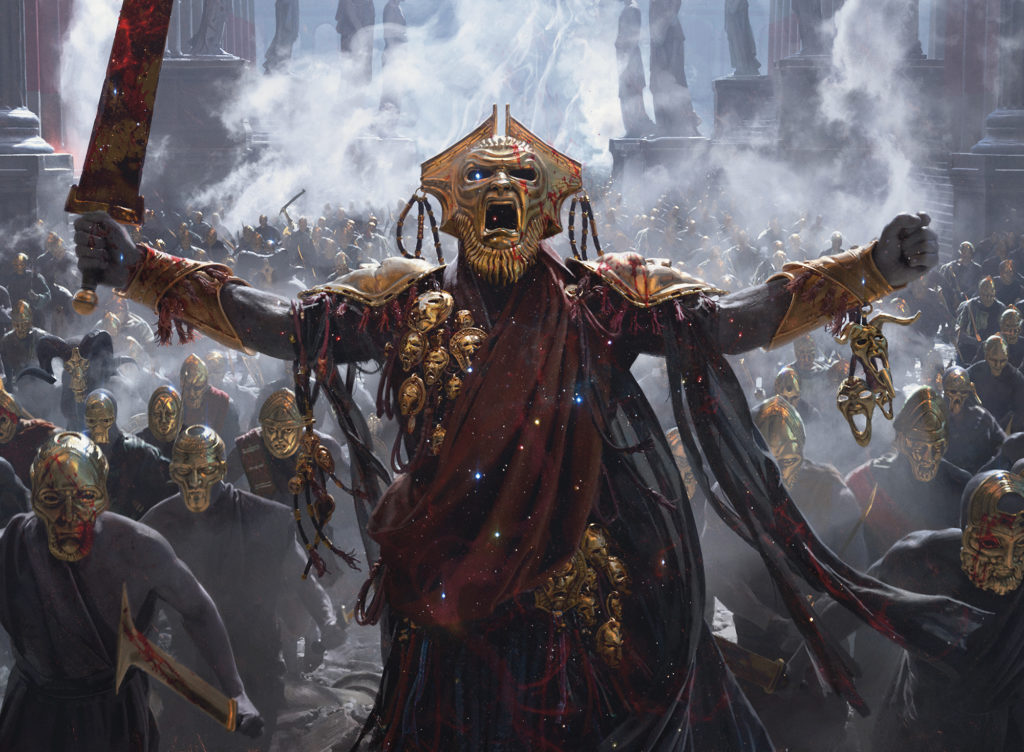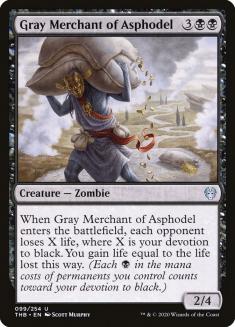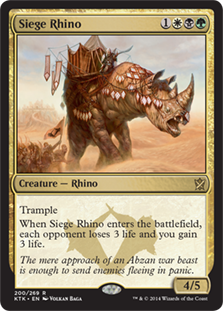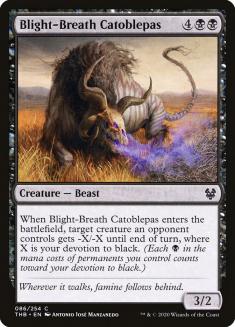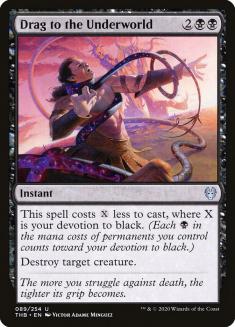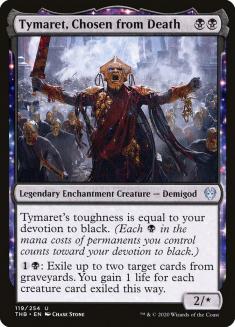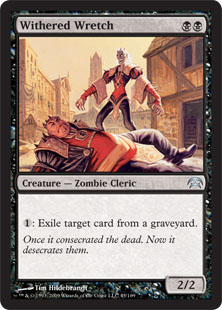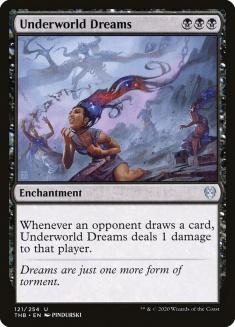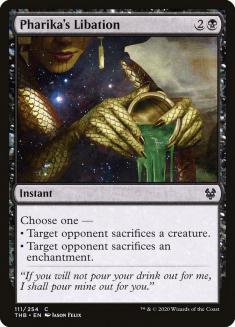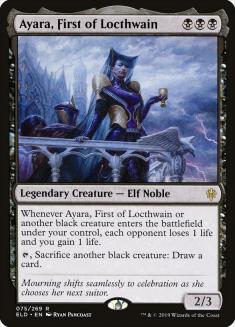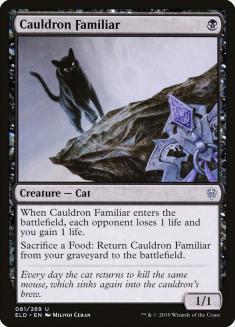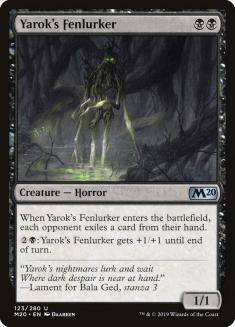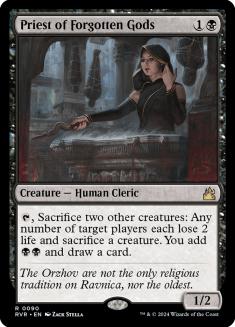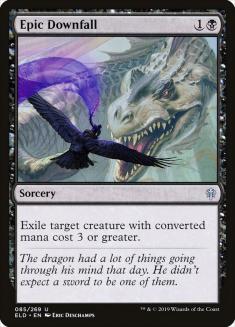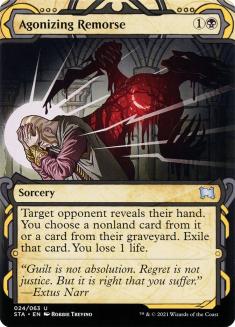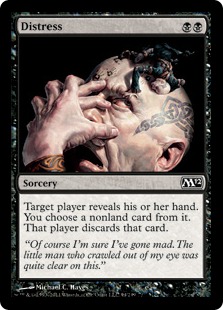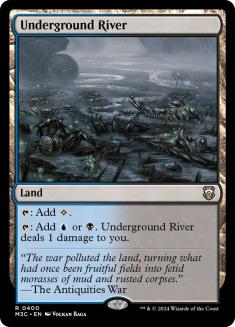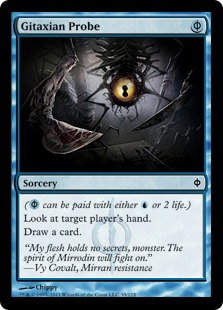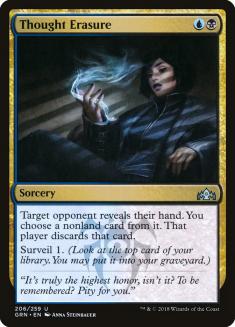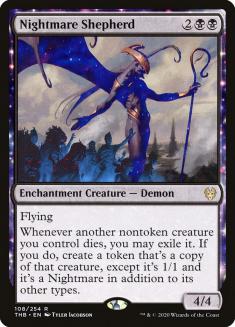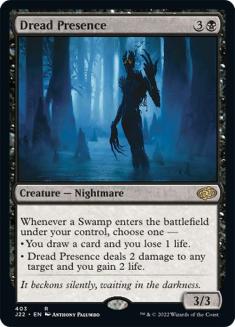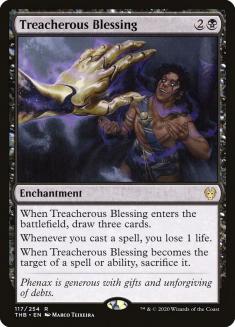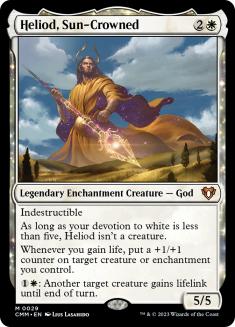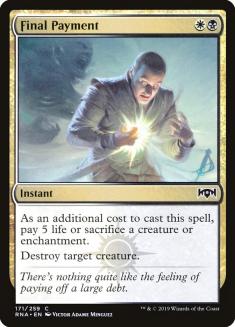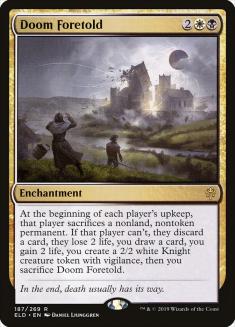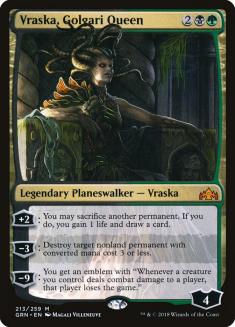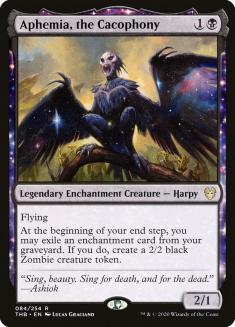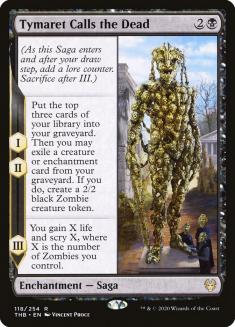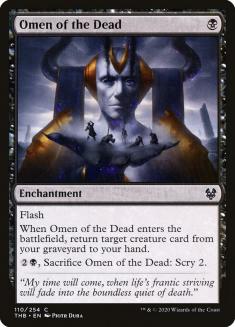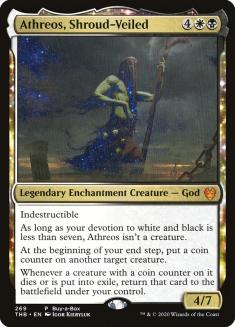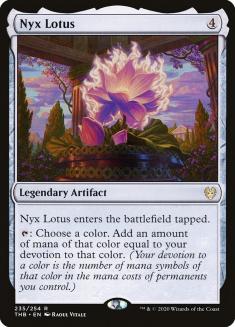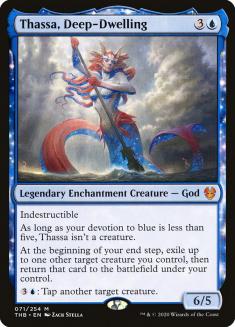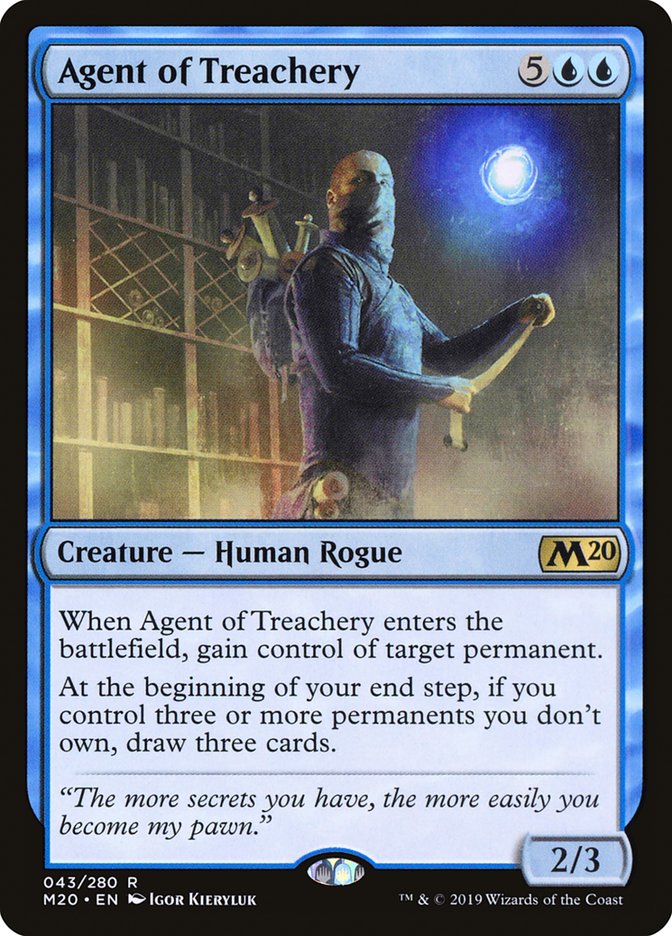With the full Theros Beyond Death set list previewed, we’ve got everything we need to get down to business. The last Theros set was initially disorienting to players who took months to figure out how to build decks in the new world it made possible. We can get so used to valuing advantages like cards in hand, extra lands, or life total in a way that can need some revisiting once we’ve got access to powerful incentives to accumulate actual permanents with mana symbols.
The return of Gray Merchant of Asphodel is one such incentive, and a particularly enticing one at that. It’s not “good enough” on its own, as a 2/4 for five that drains your opponent for two wouldn’t get there in today’s world, but it scales without limit. To get a sense of how much we need to scale it to get our money’s worth, we can compare it to Siege Rhino. It’s not that Siege Rhino is somehow the bar, but I think we can all agree, Siege Rhino is a very rare card with a comparable effect, and we need Gray Merchant to aspire to very high levels in order to make up for the turns and games where casting it will be the low end of its range. Remember, the floor isn’t draining for two; it’s draining for zero when they kill the Gray Merchant in response to the trigger.
Setting aside color requirements, Siege Rhino is a 4/5 instead of a 2/4, costs a mana less, and even has trample. How much devotion to black does it take before Gray Merchant even pulls ahead?
- BBB – This gets us to even on the drain, but Siege Rhino is bigger and cheaper.
- BBBB – Now we’re draining for one more than the Rhino, but everything else equal, we’d generally prefer a four-cost Siege Rhino to a five-cost one that drains for four, but it’s at least close. At the very least, there’s no way it’s making up for the much smaller stats of Gray Merchant. It’s not that draining our opponent for four is bad. I mean, even Soul Feast has shown up in tournament play. We’re just aiming high by comparing it to Siege Rhino.
- BBBBB – Now we’re really getting somewhere. Draining your opponent for five instead of three is generally worth well more than an extra mana. Even if we’re generously assuming it to be worth +1/+1 and the extra mana in cost, we’re still a little short of Siege Rhino.
- BBBBBB – Now we’re into some pretty crazy space, which is good, because Siege Rhino lives in crazy space. At six devotion, we’re doubling Siege Rhino’s enters the battlefield ability in exchange for +2/+1 worth of stats, trample, and a mana in the cost.
Another way to look at this exchange is to look at what Siege Rhino would look like if we made the trade in the other direction:
Alt Universe Siege Rhino – WBG
Trample
5/6
That would be a pretty incredible card, clearly better than anything they’ve done in that vein, but that is basically the rate Siege Rhino is at. It’s not totally fair, as this version isn’t “gaining” trample compared to Siege Rhino; however, the difference between three-cost and four-cost is meaningfully bigger than the difference between four-cost and five-cost anyway.
All this is to say, I think draining for three is worth a little more than the stats, trample, and cost. Once we’re draining for six, we’re actually well into Siege Rhino territory, and anything beyond that is just incredible.
This exercise isn’t just for sport, either. Realizing that we’ve got to aspire to six black devotion to really get our money’s worth means we’re probably not going to go too far down the path of using Gray Merchant as a top-end for some fast black aggro deck. For instance:
Creatures (34)
- 4 Gray Merchant of Asphodel
- 4 Spawn of Mayhem
- 4 Gutterbones
- 4 Knight of the Ebon Legion
- 2 Rankle, Master of Pranks
- 2 Smitten Swordmaster
- 4 Order of Midnight
- 4 Murderous Rider
- 2 Oathsworn Knight
- 4 Blacklance Paragon
Lands (23)
Spells (3)

The battlefields where we’ve actually got four black devotion already and can drop a Gray Merchant are so frequently going to involve games where we’re already winning. Like, what does it look like for a deck like this to have that many permanents and not be making forward progress? If we’ve got that many threats and can’t attack, what does our opponent’s battlefield look like?
Instead, I think we probably want to lean either more towards the “sacrifice creatures for value” direction or towards something more “Mono-Black Midrange,” like the last black devotion deck was. Here’s an attempt at the latter:
Creatures (29)
- 4 Gray Merchant of Asphodel
- 4 Gutterbones
- 2 Massacre Girl
- 1 Dread Presence
- 4 Yarok's Fenlurker
- 4 Murderous Rider
- 4 Ayara, First of Locthwain
- 3 Erebos, Bleak-Hearted
- 3 Tymaret, Chosen from Death
Lands (26)
Spells (5)

Now we’re talking about a strategy that could realistically be getting up to six or more black devotion, thanks to the card advantage, the blocking potential, and the diverse mix of permanents that can stretch the game out a bit. First, though, a black devotion card we’re not playing, despite how much it would be on-theme.
With Gray Merchant an uncommon this time around, there’s a new black devotion creature at common. However, it’s rate is definitely aimed at making Draft a good experience, rather than representing a serious Constructed player. Blight-Breath Catoblepas aspires to be a six-mana 3/2 Ravenous Chupacabra. That’s just not remotely good enough for Constructed, and there’s no amount of devotion that can get it over the line, since the devotion scales in a direction that has a binary cap (you have enough to kill or you don’t).
As far as binary black devotion kill cards go, I think it’s pretty obvious that Drag to the Underworld is the one priced to move for Constructed.
Drag to the Underworld is a very different kind of devotion card from Gray Merchant of Asphodel. While Gray Merchant wants you to be as all-in as possible and gives a reward with unlimited scaling, Drag to the Underworld is a tightly capped incentive with just three possible states.
Without any devotion to black, you’re paying a mana more than Murder. With one devotion you’re back to par, and with two or more devotion, you’re now getting a mana discount on Murder.
How good is Drag to the Underworld? Obviously, this is gonna end up depending on both how naturally we end up with the devotion, as well as how much this kind of a kill spell is even what we want to buy (since there are plenty of reasons to want to play more flexible kill spells like Murderous Rider or cheaper removal spells like Dead Weight).
Besides, it’s not like Murder is actually some tournament staple or anything. That said, I do think it’s meaningfully better than Murder. It’s just so easy to get two devotion early and use Drag to the Underworld as a tempo-positive play fairly early, or at least in the mid-game. That you can cast a BB two-drop like Tymaret, Chosen from Death on Turn 4 and then immediately play Drag to the Underworld in the same turn, at a discount, before your opponent has a chance to kill it, is actually pretty excellent for making sure you get to make two good plays in a turn.
Tymaret starts off as a sort of Withered Wretch / Scavenging Ooze hybrid. He’s got most of the mana efficiency of Withered Wretch, but the lifegain bonus of Scavenging Ooze. The graveyard disruption ability seems great in the new format, and the extra life will really help make up for all the life we’ll pay other ways.
As for the devotion ability, gaining tons of backside isn’t the most naturally alluring scaling design, but it does make it an interesting game piece that is likely to be able to hold the ground much better than might be obvious on the surface. For instance, imagine you follow a Turn 2 Tymaret up with the newly reprinted Underworld Dreams.
Suddenly, you’ve got a 2/5 for two with upside, and that high of toughness generally sort of pushes the game in a direction in which you’ll be able to accumulate even more devotion, stalling things out to hopefully start Gray Merchanting people.
As for Underworld Dreams itself, it’s certainly not so strong a card that you just want to jam it into decks for no reason. However, it is an exciting threat against do-nothing control decks and some possible combo decks one can conceive of. If you’re trying to play some Simic deck that just draws cards and makes mana, this is not what you want to see on Turn 3.
Besides, Underworld Dreams does contribute a lot of black devotion, and it’s a threat that doesn’t get removed by most black or red removal spells. Topically, however, black does have a really new kind of removal spell that can actually kill enchantments.
For one mana more than Diabolic Edict (or Liliana’s Triumph), you get the option to Edict them for enchantments instead, should you desire. This might seem a little jarring at first, with black mostly not being able to kill enchantments for the first 26 years of Magic; however, times change and the relative balance of types of threats and answers has evolved. Having only two colors able to kill enchantments just allow for as much design space, particularly when both of those colors can also kill artifacts.
Black having a very modest ability to kill enchantments but not artifacts actually contrasts really well with red having the ability to kill artifacts but not enchantments. Obviously, it’s all fun and games when the offering is modest, but useful. Hopefully black’s ability to kill enchantments stays flavorfully linked (because surely they will eventually desire to push the boundaries and make a non-Edict style spell, again expanding the range).
Jumping back to Tymaret, the real three-drop I’m expecting to be paired most with him is Ayara, First of Locthwain.
Ayara isn’t just a major source of devotion, she’s also a virtual black devotion reward herself, doing a little bit of Gray Merchanting when she enters the battlefield and then continuing to do so as long as she sticks around.
Her activated ability is also quite strong, first as a way to keep the cards flowing, getting us extra mileage out of recursion creatures or creatures with enters- or leaves-the-battlefield triggers.
Just because we’re not fast aggro, that doesn’t mean we can’t play some aggressive cards if they’re on-plan. Gutterbones can serve as a fast aggressive threat, but it’s also a great card to sacrifice to Ayara. It’s also a better potential blocker than Scrapheap Scrounger ever was.
If we wanted, I could imagine taking this deck towards more of a Cauldron Familiar direction. Just because we’re playing black devotion, that doesn’t mean we couldn’t splash green or red. There’s a cost, of course, but we don’t have to be actual mono-black.
Coming from the other side a little, Yarok’s Fenlurker is a great creature to sacrifice to Ayara, as we’ll have already gotten value out of it. That said, if we’ve got no good way to sacrifice it, it can still be a powerful threat, particularly if we’ve got nothing else to spend our mana on, in the late-game.
I could definitely be into building in more of a Priest of Forgotten Gods direction, which might not necessarily keep us Gray Merchant-aligned but could really bring out the best of Ayara and Erebos. Regardless, I’m excited to pair Ayara with Erebos anyway. She works excellently with him, and even if we don’t draw her, the cards that work well with her are going to work well with him.
There are three distinct aspects of Erebos, even if they interlock with each other. For starters, it might not be immediately obvious, but the creature mode of Erebos is actually pretty important. A four-cost 5/6 indestructible creature with no drawback would be really strong, even with nothing else going on. We’re not always going to have five black devotion, but it’s useful for framing the card. That simply getting enough devotion gets us a good deal means we can evaluate the other abilities through a lens that doesn’t require them to carry the weight of a card.
If we thought we’d have him awake 67% of the time, we might be content with only 33% of a card’s worth of investment. Another way to think about it is the difference between a card that draws a card versus one that doesn’t. The one that draws a card just needs to do enough to make up for the mana you spend on it and the opportunity cost of the time it sits in your hand before you can cast it. The one that doesn’t draw a card also needs to make up for a full card’s worth of material you are investing into it.
“When one of your creatures dies, you can pay two life to draw a card” is definitely a quality ability. Generally, cards are worth more than two life, particularly when we’ve got the option to only buy them at such a rate when we’re not too low. That is a both a lot of power from card advantage and a lot of life loss, so we’re going to really value incidental lifegain. Life steal, draining kill spells, Gray Merchant, Ayara…there’s definitely a lot of compelling options that have extra value to us in light of Erebos.
Remember, we’re not even talking about sacrificing creatures, but rather triggering on them dying however they might die. This could be from trading in combat, opposing removal spells, or sacrificed to some other ability like Ayara’s or Erebos’s other ability.
Spending two mana and sacrificing a creature to give a creature -2/-1 until end of turn may not seem immediately powerful, but again, context is crucial. That we’re sacrificing a creature is less of a cost when we’re inherently getting an option to pay two life to draw a card at the same time. As for the -2/-1 debuff itself, remember this is at instant speed. Isn’t this just going to make combat absolutely nightmarish for our opponent?
Even when we’re not killing the creature we’re targeting, we might still be getting ahead of the game. For instance, let’s say we have one chump blocker and we’re against two attackers. Blocking one of them with the small creature and then sacrificing it to shrink the other prevents two damage more than a typical chump blocker, offsetting the two life we pay to try to dig to answers.
One kind of niche interaction I think is interesting is the possibility of using Erebos to turn off his own devotion. I could imagine a situation in which someone tries to Epic Downfall our Erebos and we actually choose to sacrifice our Ayara to his -2/-1 ability in order to drop our devotion back down below five, making Epic Downfall countered upon resolution.
As for all the life payment Erebos brings, along with Ayara and Murderous Rider, it all adds up, and that’s not even the end of it.
Agonizing Remorse is a potent new Thoughtseize variant with three different “upsides” in exchange for costing 1B instead of B. For starters, paying one life isn’t that big a deal, but it is something. There have definitely been times where the two life from Thoughtseize wasn’t worth it compared to Duress, at least in some numbers. If we compare Thoughtseize to Distress, we can get some sense of the balance here.
Distress has been a role-player several times, but never anything remotely like the dominant force Thoughtseize is. Generally speaking, saving a mana here is worth well more than two life. What would be stronger? Shocklands without the option to play them tapped, that always deal two to you, or Guildgates? I would say the shocklands that always deal two. They’d probably still be better than tournament staples like Underground River.
The Ravnica shocklands are just incredibly powerful. Anyway, this comparison is just to illustrate that the two options “two life” or “costs one more mana” aren’t equal, and even if we choose the “costs one more mana” option more often, the “two life” mode is generally more powerful. We’re talking about Phyrexian mana here.
Besides, casting a discard spell a turn early is even more valuable than casting a creature a turn early. Most creatures cast a turn early just get an extra attack in. A discard spell a turn early increases the range of options of what you can take and reduces the risk of having nothing worth taking.
Okay, so Thoughtseize is more powerful than Distress, got it. What about Agonizing Remorse? Well, compared to Distress, the one life is probably a slightly bigger drawback than needing BB instead of 1B (at least for black devotion decks). What about the other two upsides?
Exiling the card you choose is a solid improvement. Generally, whatever we would want to make our opponent discard is going to be above average, likely to be something we’d prefer for them to not have access to later. This is especially true in a format with the escape mechanic. Just from looking at raw rate, I’d say the exile portion is enough to stack with the cost to get up to about Distress levels. Now, what about this last mode?
The ability to trade a card, a life, and two mana to exile a card in your opponent’s graveyard may seem like a really bad deal, but remember, we’re talking about a modal card. You don’t even need to decide until after you look at their hand. Compare this to Thoughtseize, where you end up with a mostly dead draw later. Instead, you’ve got a tactical weapon that gives you maindeckable answers to graveyard cards, and when you’d want to sideboard Agonizing Remorse in, you’re likely to be extra interested in even more graveyard fighting options.
In light of this graveyard “hate” mode, I think Agonizing Remorse gets a clear edge over Distress, but that’s just not enough to get it anywhere near Thoughtseize levels (which is a good thing). This card is a lot more comparable to Thought Erasure, and even there, I give the nod to Thought Erasure.
Thought Erasure is the slightly stronger card, assuming mana is no issue, but Agonizing Remorse is at its best in decks that don’t have access to blue mana anyway. Besides, if life total is no issue either, there will be spots where Agonizing Remorse even performs better.
Nightmare Shepherd is kind of a wildcard that could turn out awesome. It’s definitely better in decks that have both sacrifice effects and enters-the-battlefield triggers, and any enchantment synergies are going to be a plus. If we ever get to retrigger Gray Merchant, we’re kind of doing it.
- Turn 2 – Tymaret, Chosen by Death
- Turn 3 – Ayara, First of Locthwain
- Turn 4 – Nightmare Shepherd
- Turn 5 – Gray Merchant of Asphodel
Still, there’s a lot of competition at the four-spot, and this is a pretty high-investment permanent compared to Erebos or Dread Presence, so it would not surprise me at all if Nightmare Shepherd was for Golgari or Orzhov decks rather than black devotion.
Maybe it’s too cute, but I could actually imagine Dread Presence for value being a reasonable way to get extra life, extra card advantage, and extra support for the Ayara/Gray Merchant draining plan. I want to be cautious about diving in too deep on this one, but I think it’s worth a shot.
Treacherous Blessing is really cool, but I think it’s outside the scope of black devotion. Amusingly, it actually works much better in white devotion.
With Heliod on the battlefield, the first time you gain life, you can put the +1/+1 counter on Treacherous Blessing, getting rid of it (with you walking away with a three-mana draw three for your trouble).
Final Payment isn’t quite as good as other options, at least on the surface, but the ability to turn Treacherous Blessing into an asset you can use, instead of a drawback, is both fun and potentially strong.
Similarly, Doom Foretold can turn Treacherous Blessing on the battlefield into an asset, though this one definitely takes you down kind of an extreme direction. Even if we’re not willing to go that far, if we can manage a third color, green offers Vraska, Golgari Queen as an option for sacrificing Treacherous Blessing for value.
Besides, green has plenty of enchantment and self-mill synergies, so there might be something there. Also, with all these enchantments going to the graveyard, it’s also not out of the question to imagine Aphemia, the Cacophony finding a role to play.
Again, probably not really a black devotion card, unless we go really long on Dead Weight, Mire’s Grasp, and Tymaret Calls the Dead.
This one looks a fair bit less reliable than History of Benalia, but it could also be a sleeper that turns out to be a tournament staple, if 80% of a History of Benalia is actually still quite good. The big thing is going to be finding a deck for it that values the self-mill enough. The first place my mind goes to is a Cauldron Familiar deck, though there are also plenty of options with Emry, Lurker of the Loch or escape cards.
A cool card, but we’d have to be really into the black devotion it’s contributing and/or its status as an enchantment.
Heliod, Sun-Crowned looks amazing. Athreos, Shroud-Veiled, however, does not. Even if it was awake all the time, the indestructible creature wouldn’t be as strong as other six-mana options, and the two abilities are actually just one ability, and not one that seems worth six mana to me.
Nyx Lotus has some obvious similarities to Nykthos, Shrine to Nyx; however, I don’t think it can go in nearly the same range of decks, as the opportunity cost is just too high. While there are some really attractive black cards that could make Nyx Lotus a viable black devotion card, I think it looks more attractive in a Blue Devotion deck. It could let us start casting Agent of Treachery on Turn 5, and Thassa, Deep-Dwelling plus Agent of Treachery is a pretty intense one-two punch if you’ve got the mana for it.
As for black devotion, we may not have a Thoughtseize nearly as powerful, nor anything remotely resembling Pack Rat, but I think there’s enough here to build a solid foundation that could prove to have the right types of threats and interaction to be a major player.

